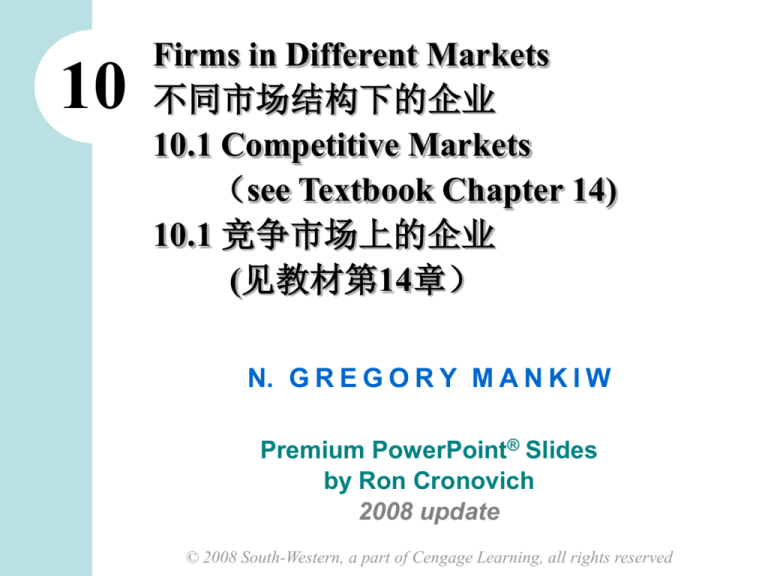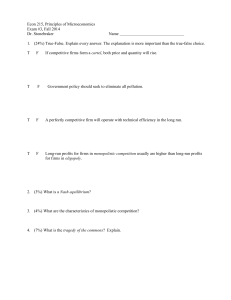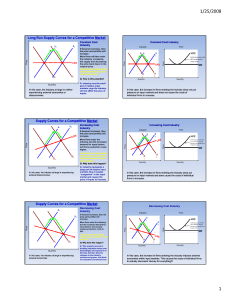
10
Firms in Different Markets
不同市场结构下的企业
10.1 Competitive Markets
(see Textbook Chapter 14)
10.1 竞争市场上的企业
(见教材第14章)
N. G R E G O R Y M A N K I W
Premium PowerPoint® Slides
by Ron Cronovich
2008 update
© 2008 South-Western, a part of Cengage Learning, all rights reserved
In this chapter, look for the answers to
these questions:
What is a perfectly competitive market?
What is marginal revenue? How is it related to
total and average revenue?
How does a competitive firm determine the
quantity that maximizes profits?
When might a competitive firm shut down in the
short run? Exit the market in the long run?
What does the market supply curve look like in the
short run? In the long run?
1
Introduction: A Scenario
简介:情景讨论
Three years after graduating, you run your own
business.
You must decide how much to produce, what price
to charge, how many workers to hire, etc.
What factors should affect these decisions?
• Your costs (studied in preceding chapter)
• How much competition you face
We begin by studying the behavior of firms in
perfectly competitive markets.
2
Characteristics of Perfect Competition
完全竞争的特征
1. Many buyers and many sellers
2. The goods offered for sale are largely the same.
3. Firms can freely enter or exit the market.
Because of 1 & 2, each buyer and seller is a
“price taker” – takes the price as given.
3
The Revenue of a Competitive Firm
竞争企业的收益
Total revenue (TR)
TR = P x Q
Average revenue (AR)
TR
=P
AR =
Q
Marginal Revenue (MR):
The change in TR from
selling one more unit.
∆TR
MR =
∆Q
4
ACTIVE LEARNING
Exercise
1:
Fill in the empty spaces of the table.
Q
P
TR
0
$10
n.a.
1
$10
$10
2
$10
3
$10
4
$10
AR
MR
$40
$10
5
$10
$50
5
ACTIVE LEARNING
Answers
1:
Fill in the empty spaces of the table.
Q
P
TR = P x Q
0
$10
$0
AR =
TR
Q
MR =
∆TR
∆Q
n.a.
$10
1
2
3
$10
$10
$10
Notice that
$20
$10
MR = P
$10
$30
$10
$10
$10
$10
$10
4
$10
$40
$10
$10
5
$10
$50
$10
6
MR = P for a Competitive Firm
对竞争企业而言,边际收益等于物品的价格
A competitive firm can keep increasing its output
without affecting the market price.
So, each one-unit increase in Q causes revenue
to rise by P, i.e., MR = P.
MR = P is only true for
firms in competitive markets.
7
Profit Maximization
利润最大化
What Q maximizes the firm’s profit?
To find the answer,
“Think at the margin.”
If increase Q by one unit,
revenue rises by MR,
cost rises by MC.
If MR > MC, then increase Q to raise profit.
If MR < MC, then reduce Q to raise profit.
8
Profit Maximization
利润最大化
(continued from earlier exercise)
At any Q with
MR > MC,
increasing Q
raises profit.
At any Q with
MR < MC,
reducing Q
raises profit.
Q
TR
TC
0
$0
$5
–$5
1
10
9
1
2
20
15
5
3
30
23
7
4
40
33
7
5
50
45
Profit MR MC
Profit =
MR – MC
$10 $4
$6
10
6
4
10
8
2
10
10
0
10
12
–2
5
9
MC and the Firm’s Supply Decision
边际成本与企业的供给决策
Rule: MR = MC at the profit-maximizing Q.
At Qa, MC < MR.
So, increase Q
to raise profit.
Costs
MC
At Qb, MC > MR.
So, reduce Q
to raise profit.
At Q1, MC = MR.
Changing Q
would lower profit.
MR
P1
Q a Q1 Q b
Q
10
MC and the Firm’s Supply Decision
边际成本与企业的供给决策
If price rises to P2,
then the profitmaximizing quantity
rises to Q2.
The MC curve
determines the
firm’s Q at any price.
Costs
MC
P2
MR2
P1
MR
Hence,
the MC curve is the
firm’s supply curve.
Q1
Q2
Q
11
Shutdown vs. Exit
停止营业与退出
Shutdown:
A short-run decision not to produce anything
because of market conditions.
Exit:
A long-run decision to leave the market.
A key difference:
• If shut down in SR, must still pay FC.
• If exit in LR, zero costs.
12
A Firm’s Short-run Decision to Shut Down
企业短期停止营业决策
• Cost of shutting down:
revenue loss = TR
• Benefit of shutting down:
cost savings = VC
(firm must still pay FC)
So, shut down if TR < VC.
Divide both sides by Q: TR/Q < VC/Q
So, firm’s decision rule is:
Shut down if P < AVC
13
A Competitive Firm’s SR Supply Curve
竞争企业SR的供给曲线
The firm’s SR
Costs
supply curve is
the portion of
its MC curve
If P > AVC, then
above
AVC.
firm produces Q
where P = MC.
If P < AVC, then
firm shuts down
(produces Q = 0).
MC
ATC
AVC
Q
14
The Irrelevance of Sunk Costs
与沉淀成本无关
Sunk cost: a cost that has already been
committed and cannot be recovered
Sunk costs should be irrelevant to decisions;
you must pay them regardless of your choice.
FC is a sunk cost: The firm must pay its fixed
costs whether it produces or shuts down.
So, FC should not matter in the decision to shut
down.
15
A Firm’s Long-Run Decision to Exit
企业退出一个市场的长期决策
• Cost of exiting the market:
revenue loss = TR
• Benefit of exiting the market:
cost savings = TC
(zero FC in the long run)
So, firm exits if TR < TC.
Divide both sides by Q to write the firm’s
decision rule as:
Exit if P < ATC
16
A New Firm’s Decision to Enter Market
新企业进入一个市场的决策
In the long run, a new firm will enter the market if
it is profitable to do so: if TR > TC.
Divide both sides by Q to express the firm’s
entry decision as:
Enter if P > ATC
17
The Competitive Firm’s Supply Curve
竞争企业的供给曲线
The firm’s
LR supply curve
is the portion of
its MC curve
above LRATC.
Costs
MC
LRATC
Q
18
2A:
Identifying a firm’s profit
ACTIVE LEARNING
A competitive firm
Determine
this firm’s
total profit.
Identify the
area on the
graph that
represents
the firm’s
profit.
Costs, P
MC
MR
ATC
P = $10
$6
50
Q
19
ACTIVE LEARNING
Answers
2A:
A competitive firm
Costs, P
profit per unit
= P – ATC
= $10 – 6
= $4
MC
MR
ATC
P = $10
profit
$6
Total profit
= (P – ATC) x Q
= $4 x 50
= $200
50
Q
20
2B:
Identifying a firm’s loss
ACTIVE LEARNING
A competitive firm
Determine
this firm’s
total loss,
assuming
AVC < $3.
Identify the
area on the
graph that
represents
the firm’s
loss.
Costs, P
MC
ATC
$5
MR
P = $3
30
Q
21
ACTIVE LEARNING
Answers
2B:
A competitive firm
Costs, P
MC
Total loss
= (ATC – P) x Q
= $2 x 30
= $60
ATC
$5
P = $3
loss
loss per unit = $2
MR
30
Q
22
Market Supply: Assumptions
市场供给:假设
1) All existing firms and potential entrants have
identical costs.
2) Each firm’s costs do not change as other firms
enter or exit the market.
3) The number of firms in the market is
•
•
fixed in the short run
(due to fixed costs)
variable in the long run
(due to free entry and exit)
23
The SR Market Supply Curve
短期市场的供给曲线
As long as P ≥ AVC, each firm will produce its
profit-maximizing quantity, where MR = MC.
Recall from Chapter 4:
At each price, the market quantity supplied is
the sum of quantities supplied by all firms.
24
The SR Market Supply Curve
短期市场的供给曲线
Example: 1000 identical firms.
At each P, market Qs = 1000 x (one firm’s Qs)
P
One firm
MC
P
P3
P3
P2
P2
AVC
P1
Market
S
P1
10 20 30
Q
(firm)
Q
(market)
10,000
20,000 30,000
25
Entry & Exit in the Long Run
进入或退出一个市场的长期决策
In the LR, the number of firms can change due to
entry & exit.
If existing firms earn positive economic profit,
• New firms enter, SR market supply shifts right.
• P falls, reducing profits and slowing entry.
If existing firms incur losses,
• some firms exit, SR market supply shifts left.
• P rises, reducing remaining firms’ losses.
26
The Zero-Profit Condition
零利润的条件
Long-run equilibrium:
The process of entry or exit is complete –
remaining firms earn zero economic profit.
Zero economic profit occurs when P = ATC.
Since firms produce where P = MR = MC,
the zero-profit condition is P = MC = ATC.
Recall that MC intersects ATC at minimum ATC.
Hence, in the long run, P = minimum ATC.
27
Why Do Firms Stay in Business if Profit = 0?
为什么企业利润为零仍然经营
Recall, economic profit is revenue minus all
costs – including implicit costs, like the
opportunity cost of the owner’s time and money.
In the zero-profit equilibrium,
• firms earn enough revenue to cover these costs
• accounting profit is positive
28
The LR Market Supply Curve
长期市场供给曲线
The LR market supply
curve is horizontal at
P = minimum ATC.
In the long run,
the typical firm
earns zero profit.
P
One firm
MC
P
Market
LRATC
P=
min.
ATC
long-run
supply
Q
(firm)
Q
(market)
29
SR & LR Effects of an Increase in Demand
SR & LR 对需求增长的影响
…but then an increase
A firm begins in
profits
to zero
…leadingeq’m…
to…driving
SR
Over time,
profits
induce
entry,
in
demand
raises
P,…
long-run
andfirm.
restoring
long-run
eq’m.
profits for the
shifting
S to the
right, reducing P…
P
One firm
Market
P
S1
MC
Profit
S2
ATC
P2
P2
P1
P1
Q
(firm)
B
A
C
long-run
supply
D1
Q1 Q2
Q3
D2
Q
(market)
30
Why the LR Supply Curve Might Slope Upward
为什么LR供给曲线会向上倾斜
The LR market supply curve is horizontal if
1) all firms have identical costs, and
2) costs do not change as other firms enter or
exit the market.
If either of these assumptions is not true,
then LR supply curve slopes upward.
31
1) Firms Have Different Costs
企业的成本不同
As P rises, firms with lower costs enter the market
before those with higher costs.
Further increases in P make it worthwhile
for higher-cost firms to enter the market,
which increases market quantity supplied.
Hence, LR market supply curve slopes upward.
At any P,
•
For the marginal firm,
P = minimum ATC and profit = 0.
•
For lower-cost firms, profit > 0.
32
2) Costs Rise as Firms Enter the Market
随着企业进入市场成本增加
In some industries, the supply of a key input is
limited (e.g., there’s a fixed amount of land
suitable for farming).
The entry of new firms increases demand for this
input, causing its price to rise.
This increases all firms’ costs.
Hence, an increase in P is required to increase
the market quantity supplied, so the supply curve
is upward-sloping.
33
CONCLUSION: The Efficiency of a
Competitive Market
结论:竞争性市场的效率
Profit-maximization:
Perfect competition:
So, in the competitive eq’m:
MC = MR
P = MR
P = MC
Recall, MC is cost of producing the marginal unit.
P is value to buyers of the marginal unit.
So, the competitive eq’m is efficient, maximizes
total surplus.
In the next chapter, monopoly: pricing &
production decisions, deadweight loss, regulation.
34
CHAPTER SUMMARY
For a firm in a perfectly competitive market,
price = marginal revenue = average revenue.
If P > AVC, a firm maximizes profit by producing
the quantity where MR = MC. If P < AVC, a firm
will shut down in the short run.
If P < ATC, a firm will exit in the long run.
In the short run, entry is not possible, and an
increase in demand increases firms’ profits.
With free entry and exit, profits = 0 in the long run,
and P = minimum ATC.
35
10.2 Monopoly 垄断
PRINCIPLES OF
ECONOMICS
FOURTH EDITION
N. G R E G O R Y M A N K I W
Premium PowerPoint® Slides
by Ron Cronovich
2008 update
© 2008 South-Western, a part of Cengage Learning, all rights reserved
Introduction导言
A monopoly is a firm that is the sole seller of a
product without close substitutes.
In this chapter, we study monopoly and contrast
it with perfect competition.
The key difference:
A monopoly firm has market power, the ability
to influence the market price of the product it
sells. A competitive firm has no market power.
39
Why Monopolies Arise
产生垄断的原因
The main cause of monopolies is barriers
to entry – other firms cannot enter the market.
Three sources of barriers to entry:
1. A single firm owns a key resource.
E.g., DeBeers owns most of the world’s
diamond mines
2. The govt gives a single firm the exclusive right
to produce the good.
E.g., patents, copyright laws
40
Why Monopolies Arise
产生垄断的原因
3. Natural monopoly: a single firm can produce
the entire market Q at lower ATC than could
several firms.
Example: 1000 homes
need electricity.
ATC is lower if
one firm services
all 1000 homes
than if two firms
each service
500 homes.
Cost
$80
Electricity
ATC slopes
downward due
to huge FC and
small MC
$50
ATC
500
1000
Q
41
Monopoly vs. Competition: Demand Curves
垄断与竞争:需求曲线
In a competitive market,
the market demand curve
slopes downward.
but the demand curve
for any individual firm’s
product is horizontal
at the market price.
The firm can increase Q
without lowering P,
so MR = P for the
competitive firm.
P
A competitive firm’s
demand curve
D
Q
42
Monopoly vs. Competition: Demand Curves
垄断与竞争:需求曲线
A monopolist is the only
seller, so it faces the
market demand curve.
To sell a larger Q,
the firm must reduce P.
P
A monopolist’s
demand curve
Thus, MR ≠ P.
D
Q
43
1:
A monopoly’s revenue
ACTIVE LEARNING
Moonbucks is
the only seller of
cappuccinos in town.
The table shows the
market demand for
cappuccinos.
Fill in the missing
spaces of the table.
What is the relation
between P and AR?
Between P and MR?
Q
P
0
$4.50
1
4.00
2
3.50
3
3.00
4
2.50
5
2.00
6
1.50
TR
AR
MR
n.a.
44
ACTIVE LEARNING
Answers
Here, P = AR,
same as for a
competitive firm.
Here, MR < P,
whereas MR = P
for a competitive
firm.
Q
1:
P
TR
AR
0
$4.50
$0
n.a.
1
4.00
4
$4.00
2
3.50
7
3.50
3
3.00
9
3.00
4
2.50
10
2.50
5
2.00
10
2.00
6
1.50
9
1.50
MR
$4
3
2
1
0
–1
45
10.3 Oligopoly 寡头
PRINCIPLES OF
ECONOMICS
FOURTH EDITION
N. G R E G O R Y M A N K I W
Premium PowerPoint® Slides
by Ron Cronovich
2008 update
© 2008 South-Western, a part of Cengage Learning, all rights reserved
Introduction:
Between Monopoly and Competition
简介:垄断与竞争
Two extremes
• Competitive markets: many firms, identical
products
• Monopoly: one firm
In between these extremes
• Oligopoly: only a few sellers offer similar or
identical products.
• Monopolistic competition: many firms sell
similar but not identical products.
47
Measuring Market Concentration
衡量市场集中
Concentration ratio: the percentage of the
market’s total output supplied by its four largest
firms.
The higher the concentration ratio,
the less competition.
This chapter focuses on oligopoly,
a market structure with high concentration ratios.
48
Concentration Ratios in Selected U.S. Industries
美国工业的集中比率
Industry
Video game consoles
Tennis balls
Credit cards
Batteries
Soft drinks
Web search engines
Breakfast cereal
Cigarettes
Greeting cards
Beer
Cell phone service
Autos
Concentration ratio
100%
100%
99%
94%
93%
92%
92%
89%
88%
85%
82%
79%
49
EXAMPLE: Cell Phone Duopoly in Smalltown
示例:小城市的手机双寡头
Smalltown has 140 residents
P
Q
$0
140
5
130
10
120
15
110
20
100
25
90
30
80
(duopoly: an oligopoly with two firms)
35
70
Each firm’s costs: FC = $0, MC = $10
40
60
45
50
The “good”:
cell phone service with unlimited
anytime minutes and free phone
Smalltown’s demand schedule
Two firms: T-Mobile, Verizon
50
EXAMPLE: Cell Phone Duopoly in Smalltown
示例:小城市的手机双寡头
P
Q
Revenue
Cost
Profit
$0
140
5
130
650
1,300
–650
10
120
1,200
1,200
0
15
110
1,650
1,100
550
20
100
2,000
1,000
1,000
25
90
2,250
900
1,350
30
80
2,400
800
1,600
35
70
2,450
700
1,750
40
60
2,400
600
1,800
45
50
2,250
500
1,750
$0 $1,400 –1,400
Competitive
outcome:
P = MC = $10
Q = 120
Profit = $0
Monopoly
outcome:
P = $40
Q = 60
Profit = $1,800
51
EXAMPLE: Cell Phone Duopoly in Smalltown
示例:小城市的手机双寡头
One possible duopoly outcome: collusion
Collusion: an agreement among firms in a
market about quantities to produce or prices to
charge
T-Mobile and Verizon could agree to each produce
half of the monopoly output:
• For each firm:
Q = 30, P = $40, profits = $900
Cartel: a group of firms acting in unison,
e.g., T-Mobile and Verizon in the outcome with
collusion
52
1:
Collusion vs. self-interest
ACTIVE LEARNING
P
Q
$0
140
5
130
10
120
15
110
20
100
25
90
30
80
35
70
40
60
45
50
Duopoly outcome with collusion:
Each firm agrees to produce Q = 30,
earns profit = $900.
If T-Mobile reneges on the agreement and
produces Q = 40, what happens to the
market price? T-Mobile’s profits?
Is it in T-Mobile’s interest to renege on the
agreement?
If both firms renege and produce Q = 40,
determine each firm’s profits.
53
ACTIVE LEARNING
Answers
P
Q
$0
140
5
130
10
120
15
110
20
100
25
90
30
80
35
70
40
60
45
50
1:
If both firms stick to agreement,
each firm’s profit = $900
If T-Mobile reneges on agreement and
produces Q = 40:
Market quantity = 70, P = $35
T-Mobile’s profit = 40 x ($35 – 10) = $1000
T-Mobile’s profits are higher if it reneges.
Verizon will conclude the same, so
both firms renege, each produces Q = 40:
Market quantity = 80, P = $30
Each firm’s profit = 40 x ($30 – 10) = $800
54
Collusion vs. Self-Interest
合作与自我兴趣
Both firms would be better off if both stick to the
cartel agreement.
But each firm has incentive to renege on the
agreement.
Lesson:
It is difficult for oligopoly firms to form cartels and
honor their agreements.
55
2:
The oligopoly equilibrium
ACTIVE LEARNING
P
Q
$0
140
5
130
10
120
15
110
20
100
25
90
30
80
35
70
40
60
45
50
If each firm produces Q = 40,
market quantity = 80
P = $30
each firm’s profit = $800
Is it in T-Mobile’s interest to increase its
output further, to Q = 50?
Is it in Verizon’s interest to increase its
output to Q = 50?
56
ACTIVE LEARNING
Answers
P
Q
$0
140
5
130
10
120
15
110
20
100
25
90
30
80
35
70
40
60
45
50
2:
If each firm produces Q = 40,
then each firm’s profit = $800.
If T-Mobile increases output to Q = 50:
Market quantity = 90, P = $25
T-Mobile’s profit = 50 x ($25 – 10) = $750
T-Mobile’s profits are higher at Q = 40
than at Q = 50.
The same is true for Verizon.
57
10.4 Monopolistic Competition
垄断竞争
PRINCIPLES OF
ECONOMICS
FOURTH EDITION
N. G R E G O R Y M A N K I W
Premium PowerPoint® Slides
by Ron Cronovich
2008 update
© 2008 South-Western, a part of Cengage Learning, all rights reserved
Introduction to Monopolistic Competition
垄断竞争介绍
Monopolistic competition:
a market structure in which many firms sell
products that are similar but not identical.
Examples:
• apartments
• books
• bottled water
• clothing
• fast food
• night clubs
59
Comparing Perfect & Monop. Competition
完全竞争与垄断性竞争的比较
perfect
competition
monopolistic
competition
number of sellers
many
many
free entry/exit
yes
yes
long-run econ. profits
zero
zero
the products firms sell
identical
differentiated
firm has market power? none, price-taker
yes
D curve facing firm
downwardsloping
horizontal
60
Comparing Monopoly & Monop. Competition
完全垄断与垄断性竞争的比较
monopoly
monopolistic
competition
number of sellers
one
many
free entry/exit
no
yes
long-run econ. profits
positive
zero
firm has market power?
yes
yes
D curve facing firm
downwarddownwardsloping
sloping
(market demand)
close substitutes
none
many
61
Comparing Oligopoly & Monop. Competition
寡头与垄断造性竞争的比较
oligopoly
number of sellers
few
monopolistic
competition
many
importance of strategic
high
interactions between firms
low
likelihood of fierce
competition
high
low
62









